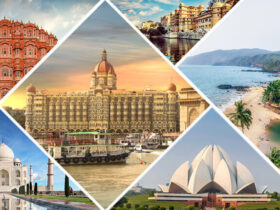Annapurna Circuit, Nepal
The hiking route of Annapurna Track, a beautiful and challenging hiking destination in the Nepal Himalayas, takes about three weeks.
The hiker starts at an altitude of about 780 meters in Besisahar and can climb up to 3,800 meters. nnapurna has everything a good hike should be, like snow-capped hills, beautiful valleys, and plenty of places to stay. It is also possible to go to Tilicho, the highest lake globally, with an altitude of 4,920 meters.
Salar de Uyuni, Bolivia
Located in South America, Bolivia, Salar de Uyuni is the world’s largest salt lake. The seven times larger than Salt Lake in Turkey.
Salar de Uyuni; resembles a more icy lake with its glowing light during the day and a harsh frost at night. While Salar de Uyuni’s salt capacity is estimated to be around 10 billion tons, up to 25 thousand tons of salt is extracted every year. The lake is a critical habitat and breeding ground for South American Flamingos.
Lake; is a beautiful center for its appearance, touristic potential, salt reserves, and a significant income source for Bolivia’s economy.
Also, there is a train cemetery near the lake, and it is possible to see trains aged 100 and over. It is essential not to forget to visit a cave with 3,000-year-old mummies near the region.
It is possible to stay in one of the salt hotels where everything is made of salt.
Angkor Wat, Cambodia
In the 12th century, King II. Built by Suryavarman and the Khmer Kingdom’s capital, Angkor was the world’s largest city until the Industrial Revolution.
One of the most important examples of Khmer architecture, the temple city, has become synonymous with Angkor Cambodia, depicted on its national flag.
Located in the middle of the forest, Angkor Wat is the world’s largest religious building.
Iguazú River, Argentina
Iguazu is a river that runs through Brazil and Argentina. The combination of the Parana and Iguazu rivers forms the natural wonder of Iguazú Falls.
Iguazú Falls consists of 20 large and 255 small waterfalls on a 2.7-kilometer stretch. The most important feature of these waterfalls is that they separate Argentina, Paraguay, and Brazil’s borders.
You can examine the waterfalls from the Brazilian side in the best way. The most important feature of the Brazilian side is to see the Devil’s Throat, which is the central part of the waterfall, in the best way.
On the Argentine side, the beginning of the waterfalls is also possible to get closer to the waterfalls in the area where hiking routes are created.
The national park, which covers both sides, was included in the UNESCO list of “World Heritage” in 1984.
Lake Bled, Slovenia
Located in Slovenia, the lake is about 55-60 kilometers from this capital Ljubljana, and transportation from the money is relatively easy. It takes approximately an hour. On the islet in the middle of the lake is St. Martin Church, you can rent a boat and go to the island. The most suitable time to visit Lake Bled is the spring months.
If we say, Slovenia is the greenest country in Europe. We will not be considered a lie. You will always see lush trees on the road. After you visit Lake Bled, you can visit Triglav National Park and see the Julian Alps.
We recommend you to taste Slovenia’s famous cream cake Kremna Rezina while drinking Bela Kava in various cafes and restaurants by the lake.
Yellowstone National Park, USA
Yellowstone National Park, which is on the UNESCO’s World Heritage list, is visited by millions of local and foreign tourists every year.
Half of the world’s hot springs are located in Yellowstone National Park, and the number of these hot springs exceeds 10 thousand. Grand Prismatic Spring, the largest in the USA and the third-largest in the world, is also located in Yellowstone National Park.
In Yellowstone National Park, visitors can enjoy hiking, camping, boat trips, and fishing activities. In the park, which broke a record with 4 million 257 thousand 177 visitors in 2016, hunting is prohibited.
Okavango Delta, Botswana
The Okavango Delta, which hosts thousands of tourists every year, is one of the Seven Natural Wonders of Africa in 2013 and was included in the World Heritage list in 2014.
When Makgadikgadi Lake dried up thousands of years ago, the Okavango Delta was formed here. The delta, which consists of lakes, lagoons, and islands, caused the Okavango River to flow its waters into the Kalahari Desert plains. This has created tremendous biodiversity in this region and is naturally attractive to all kinds of wildlife. It has a diversity of animals such as elephants, lions, leopards, slats, and crocodiles.
The waters coming into the Okavango Delta do not flow into any sea. Yet, after a while, the delta returns to the same dry state due to the evaporation of 95 percent of the waters with the temperature and mixing into the atmosphere.
It offers accommodation such as simple camps and luxury hotels in the region.
Uluru Kata Tjuta National Park, Australia
Uluru-Kata Tjuta National Park, a UNESCO World Heritage site in two different categories, is home to Australia’s most iconic natural wonder, Uluru. For the Aboriginal people who are the traditional guardians of this park and have lived here for over 30 thousand years, the park is exceptionally sacred. The park is visited by more than 200 thousand tourists every year.
Charles Darwin made his observations on some of these islands, which inspired his study of evolutionary theory. The island, which has a volcanic structure, contains many unique biological species.
Many volcanoes in the Galapagos Islands consist of overlapping lava flows, some of which are still active. Some of the species that live there, including marine iguanas, are unique in the world. For this reason, Galapagos Islands have declared a national park in 1959 and then included it in the UNESCO World Heritage List to protect animal species.
Petra, Jordan
The city of Petra remained a secret until Johann Ludwig Burckhardt discovered it in 1812. Petra is easily accessible thanks to the 1.2 km long valley called Siq, which reaches up to El-Hazen. The ancient city, known for its stone architecture and water channels, is also called Rose City because of the color of the stones used during the city’s construction.
Petra has been on the UNESCO Cultural Heritage list since 1985 and is among the most valuable cultural items in the world. Chose the ancient city as one of the “Seven New Wonders of the World” in 2007. Petra, the symbol of Jordan, is also the country’s most tourist-attracting region. The touristic area was visited by nearly a million people last year.








Leave a Reply